Who does not want to pull off a stunning hairstyle?
People spend thousands of dollars to have gorgeous hair.
They try various tools and treatments that make it more dazzling than ever.
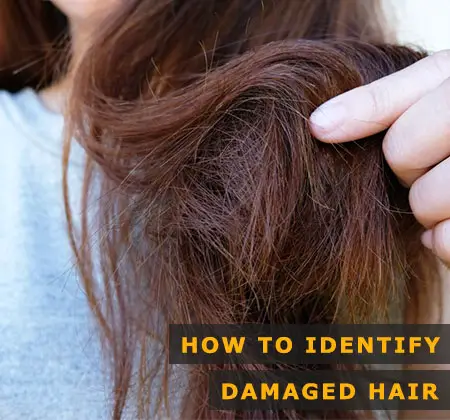
We all know nothing can be more heart-rending than having damaged, lifeless hair.
In this article, I am going to help you to identify signs of damaged hair.
Many factors can damage your hair [1].
People often get confused with the process of detecting the damage to their hair.
Therefore, I came up with a few facts that can help you understand your hair’s condition if it is damaged.
READ MORE: Know The Bad Things For Your Hair
Here’s a quick video on how to identify signs Of damaged hair.
13 Signs That Your Hair Is Damaged
1. Split Ends
Take a chunk of your hair and lightly twist it.
Cautiously look at the ends of the hairs that stands out.
If the ends are cut up, your hair is broken.
Normally the split ends [2] start to appear after 6-8 weeks of having a trim or haircut.
But, whilst dealing with broken hair, these nasty signs develop quite quickly.
If fuzzy hair is your chief adversary, then you have more probabilities of noticing the split ends.
If you notice the ends of your hair strands are brittle and splitting less than a month after a trim, then you have broken hair.
2. Texture
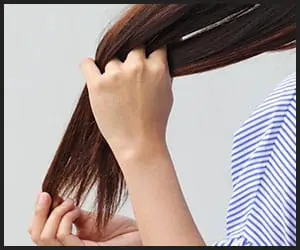
A straightforward trick is to run your hands through a single strand of your hair.
Can you run through your hair easily, or are there noticeable bumps along the strand?
If there’s an obvious distinction in smoothness on a single strand of hair from root to ends, it’s possible you got gaps on your hair strand, which is a considerable sign of breakage.
While protein treatments help fill the inside gaps quickly, the hassle can be fixed internally with proper vitamins and powerful hair nutrients.
3. Porosity of Hair
Hair that is quite porous typically means that the cuticle layer is damaged.
So your curls aren’t in a position to correctly soak up and preserve moisture.
Outside moisture accumulates in your hair’s shaft, and it starts to swell, which ultimately makes your hair frizzy[3].
As a result, your hair becomes dry and brittle.
There are some things you could try to tighten the cuticle.
4. Matting Hair
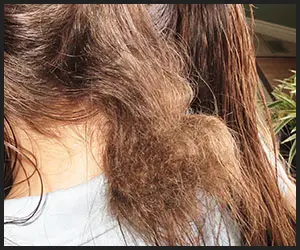
If you find yourself taking much longer than normal to detangle your hair even when it’s soaking wet with a slippery conditioner, this could be a sign that your curls are damaged.
This is because the cuticle is lifted in damaged hair, making it harder for each strand to slide past each other when combing or detangling.
5. Hair Breakage & Lost
If you notice countless hairs falling out while combing, brushing, detangling, or even running your fingers through your hair, then your hair is damaged.
Your hair shaft’s tensile strength decreases while the exterior layer is broken [4].
The hair loss usually ranges between 50 and 100 strands per day.
It’s normal to find hair strands in your drainage after your hair has been washed.
But when you start seeing hair strands on your clothes, pillows, or randomly places at home when you haven’t even combed, this is a sign of damage to your hair.
Consider testing the strands that your comb or brush has accumulated.
If you see a root bulb it may be fallacious nutrition and a poor scalp.
If there is no bulb, your hair is likely to be broken, indicating fragile or damaged hair.
6. Lack of Moisture

Hair experts always say that dry hair does not usually mean damaged hair.
However, damaged hair always tends to be dry.
If your hair lacks moisture regardless of frequent conditioning and profound conditioning treatments, it indicates hair harm.
In case of damage, hair cuticles cannot seal in humidity.
7. Dullness/Lack of Shine
Damaged hair is lacks shine.
When the cuticles are broken, the hair shafts stop glowing.
You will notice that even after a profound conditioning cure, there may be no shine with damaged hair.
Furthermore, shine loss could be a direct consequence of incorrect styling or immoderate heat styling.
Anything else that might make your hair look a bit sluggish may be due to chemical damage, such as using relaxers or hair colors that are too robust on your curls.
8. Lack of Elasticity
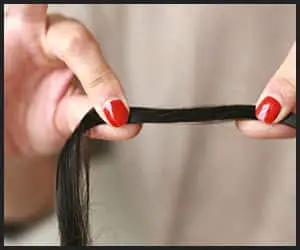
Before it snaps and breaks, your hair can extend to a certain stage.
A damaged hair strand’s elasticity is much lower than a healthy one.
If your hair is readily snapping, it’s probably damaged.
9. Tangles
The shafts of healthy hair are clean and doable, but damaged hair’s rough cuticles get tousled, resulting in knots.
The hair’s fragile nature and dryness make untangling the knots exceptionally difficult, resulting in breakage.
10. Flyaways
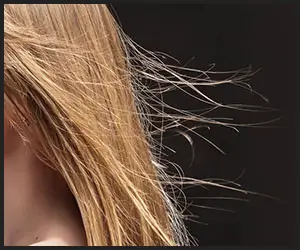
It is not just about getting rowdy hair.
Typically, this is a sign that hair moisture cannot be retained.
It may also mean breakage, leading to the protruding short hair fibers
11. Popping & Snapping
Wet, healthy hair effectively extends if it is pulled very softly.
It is normal to have elasticity in every hair strand.
If it extends a little more and then pops and snaps, then there is a lack of protein in your hair.
On the other hand, if your hair falls when you try to stretch it out straight away, your curls may be too dry and lack moisture.
These are unhealthy or harmed hair factors that are minor but essential.
12. Fading of Hair Colors
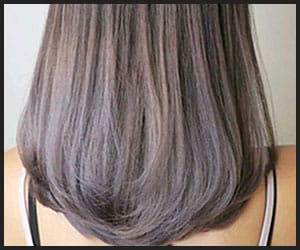
Many of us color our hair to look better or to pull off a new hairstyle.
Indeed, after a certain period of time, this color fades away.
But if you notice the fading of color a little faster than it normal,
In addition to your hair losing its vibrancy, then it can be a result of damaged hair.
13. Easily Soaked Hair
Rapidly soaked hair is a sign of damage to the hair’s natural lipid layer, leading to less flexible strands.
Also Check: The Causes Of Hair Damage
Final Verdict
Without a doubt facing hair damage is frustrating.
But it is more important to understand whether you have damaged hair or not because only then can you look for its treatment.
If you do not have any of these signs, you can relax and keep trying different hairstyles.
If you noticed any signs of damaged hair, do not panic, there are plenty of solutions.
If you use heat styling tools like a blow dryer, curling iron, or flat iron, try to use low heat settings to minimize the hair damage.
Sources
- https://www.healthline.com/health/beauty-skin-care/damaged-hair
- https://www.byrdie.com/how-to-prevent-split-ends-4693428
- Mortimer, P. S. (1985). Unruly hair. British Journal of Dermatology, 113(4),467-473.
- https://www.ncbi.nlm.nih.gov/pmc/articles/PMC3229938/
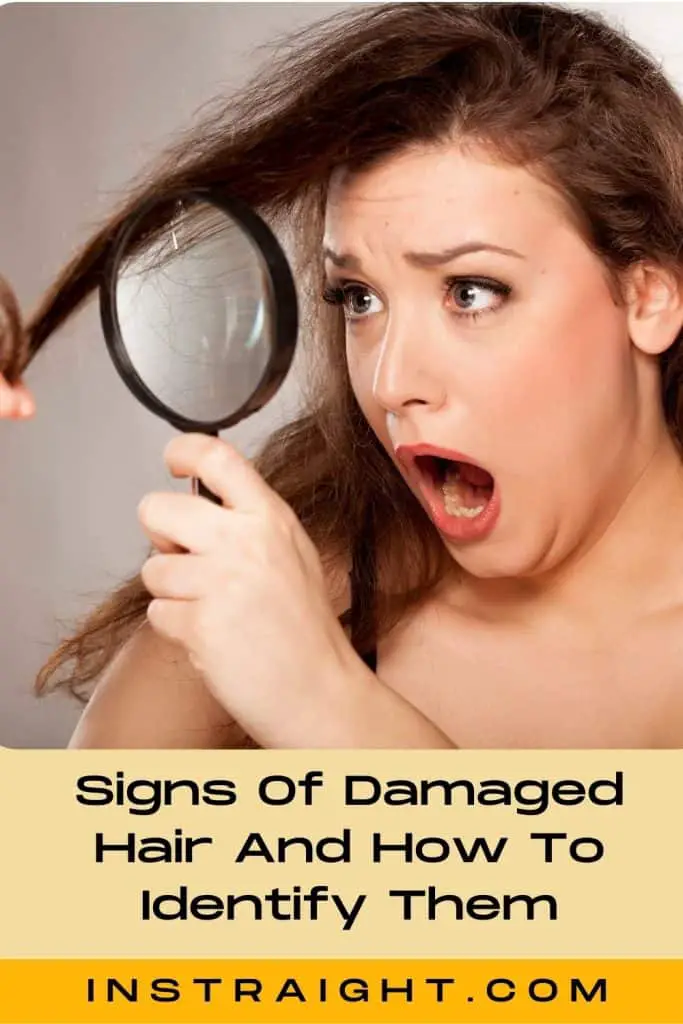
- About the Author
- Latest Posts
Martina is a graduated Doctor of Dental Medicine with a huge obsession for anything beauty-related. Her freelance writing started out as a creative outlet and turned out to be a full-time job. If you have any beauty questions, the chances are Martina has the answers. You can find more about her HERE. Follow her on LINKEDIN , INSTAGRAM


Hello people,
I must say that it is a wonderfully written article. The way you listed and talked about the signs of hair damage is more than enough for someone like me to detect hair damage super quickly. However, I am a bit confused here and am in desperate need of help.
I have fine tresses and they are dry and frizzy. I do not use conditioner often. I find conditioner greasy. Now, can you please tell me if my manes are damaged or not?
Any answers and suggestions would be helpful.
Thanks in advance.
Dear Karla,
First of all, thank you very much for your sweet, inspiring words. We are overwhelmed with your response.
Secondly, dry and frizzy manes always don’t interpret that they are damaged. Mostly, dryness and frizziness occur because of a lack of moisture. Our suggestion would be to condition and deep condition your hair and see the difference. If after the conditioning treatment, your tresses are still dry and frizzy, be sure that they are suffering from damage.
We hope this would help you.
That is a very well thought of list you have included here. I have come across a lot of articles about signs of hair damage but I have never seen such a well-planned and well-penned down article. This piece of writing is a must-read for every girl out there to find out the condition of their manes and act accordingly.
You people deserve a round of applaud.
I wish you all the success for your future.
Dear Michele,
Thank you very much for your sweet words. We appreciate our readers’ response.
Please keep coming back for more articles in the future.
I cannot deny the fact that it’s an amazing article with an adequate amount of information.
But as much as I liked your writing, I didn’t like the fact that you haven’t written anything about how to fight these signs of damage. Some suggestions would have been helpful to your readers.
Dear Luz,
Thank you very much for your suggestion. We would keep it in mind in the future.